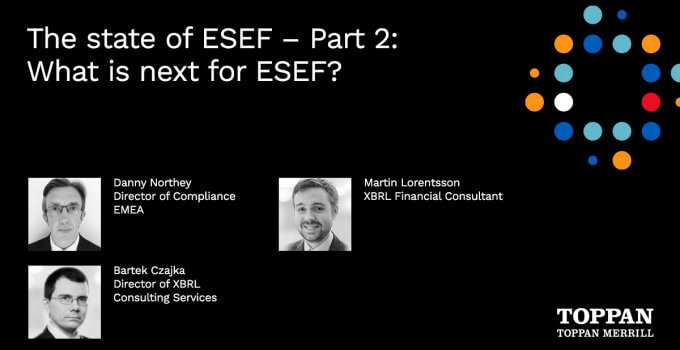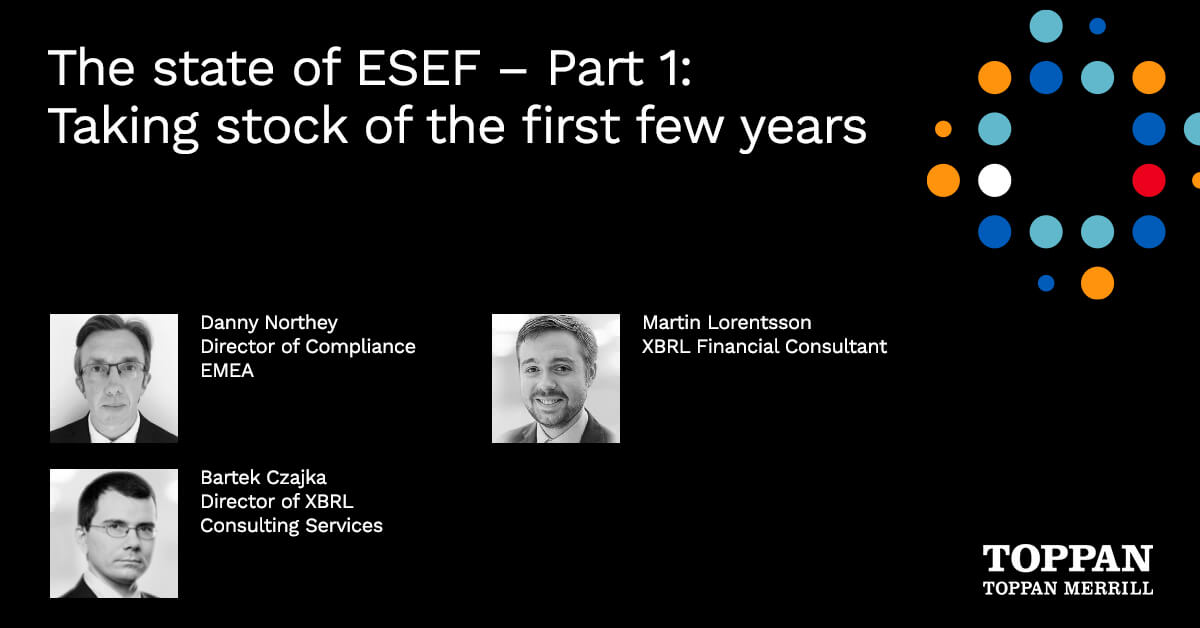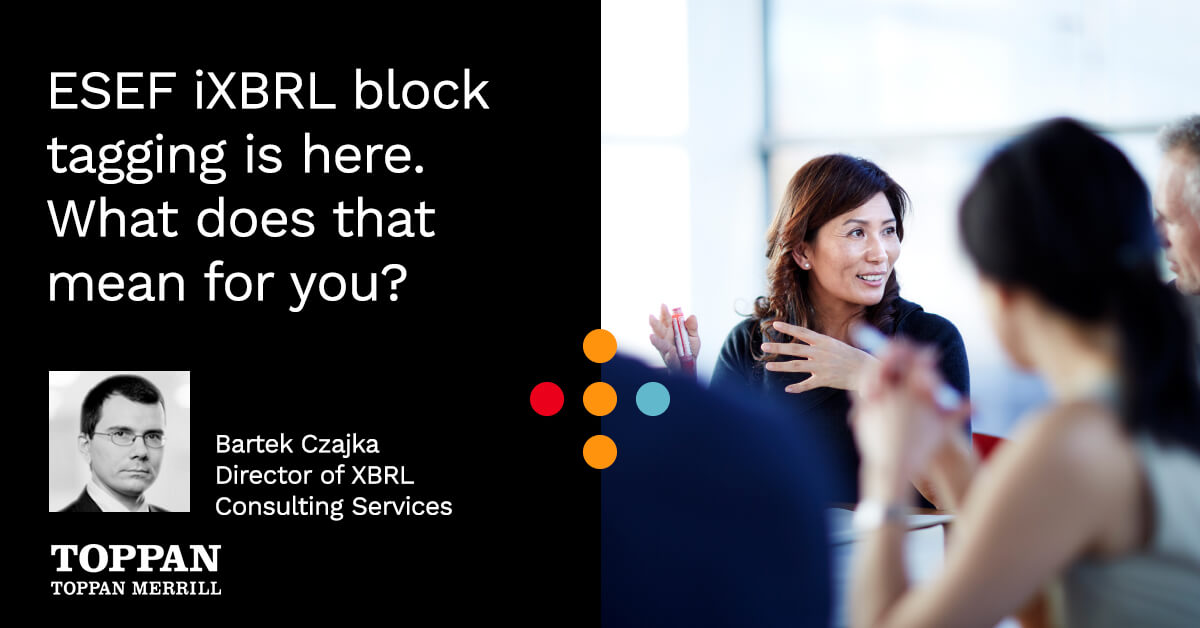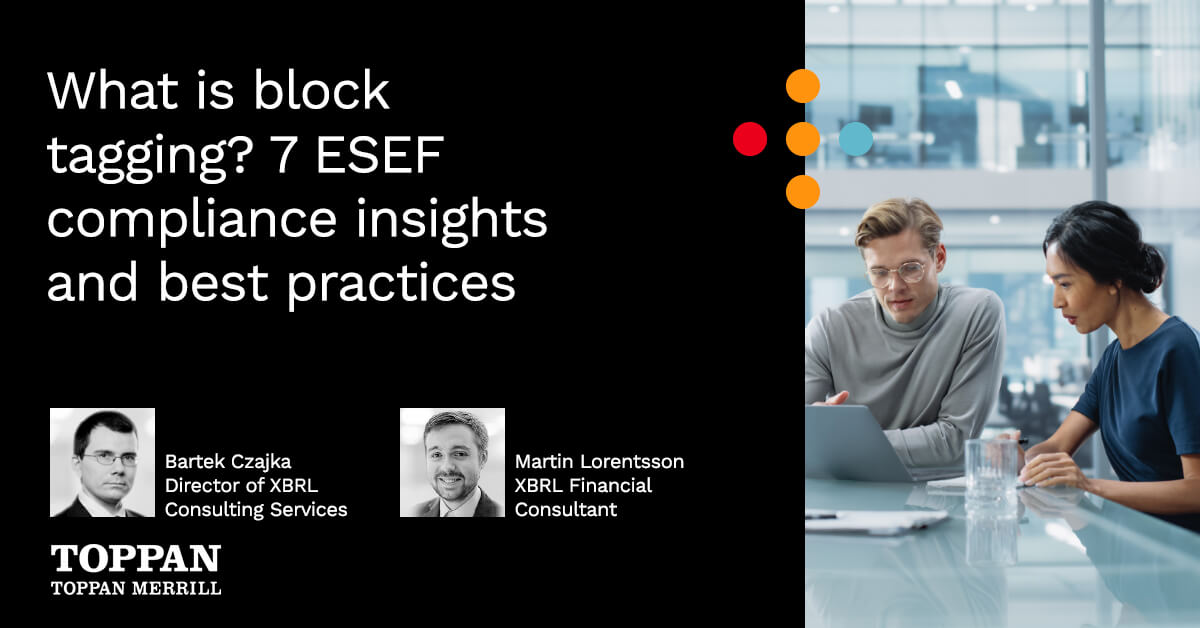Heading into Year 3 of corporate reporting under ESMA’s ESEF mandate—and the second year complying with the full extent of the mandate—we brought together three of Toppan Merrill’s top XBRL and ESEF experts for a three-part series on where we have been and where we are headed. Part 1 discussed the learning process and how filers have changed how they think about and approach ESEF compliance. Naturally, the next question is, “What is next?” We put that big question, along with several more specific questions, to our panel of experts:
Meet the ESEF experts

Danny Northey
Director of Compliance, EMEA

Bartek Czajka
Director of XBRL Consulting Services

Martin Lorentsson
XBRL Financial Consultant
What is the theme of Year 3 of ESEF reporting compliance?
Northey: Quality. We talked about it extensively in the previous post, but the first two years were essentially a compliance exercise. This year, issuers know what they need to do to “check the box.” So now, they’re looking to make sure what they’re doing is right, is the highest-quality XBRL it can be and that it tells the right story.
Czajka: Clients want to understand more about XBRL. The majority of issuers are working with service providers to help them with XBRL tagging—or to fully do the tagging for them. They increasingly are not satisfied just knowing the XBRL validates. They want to know why the service provider chose specific tags instead of other tags. If an auditor suggests a change, they want to know why that change was suggested—and make sure they agree with that change. And if their service provider can’t give them good, solid answers to those “why” questions, they’re not going to feel confident in their XBRL quality and they’re going to start looking elsewhere for guidance.
“Clients want to understand more about XBRL.”
What is next on the ESEF roadmap?
Northey: At the moment, based on the information from ESMA there are only small changes on the horizon for the ESEF requirements and nothing substantial on the roadmap. But there is a possibility that half-year reporting could be introduced in the next few years. Half-year reporting is a likely next step because the whole point of ESEF is to give stakeholders more ready access to the financial reporting data. So doing it on a more regular basis is a natural progression, particularly with the European Single Access Point (ESAP) coming down the pipeline in 2027.
Lorentsson: The reality is having the yearly reporting requirement is not really sufficient, because so much can change within one year. Just think of some of the seismic shifts and events that have occurred over the past four years—events completely changed the trajectory of organizations, even from one quarter to the next. Half-year reporting will help support the overall ESEF goal of more accurate, reliable, usable and high-quality reporting data.
Where does ESEF intersect with ESG and the EU Corporate Sustainability Reporting Directive (CSRD)?
Northey: CSRD represents the intersection of ESEF, XBRL and ESG. There is a possibility that the data available through ESEF reporting could naturally feed a CSRD report—or could at least inform that report. I believe we will see data standardisation come to CSRD, likely following the XBRL standards set forth through ESEF.
This is part of a general evolution of how all stakeholders are thinking about reporting. Everyone realises the majority of reports need to be in a digital format, so they can be easily and immediately accessible to regulators, investors, analysts, etc. Moreover, everyone understands there needs to be a standard comparable across the board, whether that’s for corporate reporting, sustainability or anything else. Without standardisation, the data becomes almost meaningless—or at least much less meaningful and usable.
Czajka: The EU’s stated aim for the CSRD is to “ensure that investors and other stakeholders have access to the information they need to assess the impact of companies on people and the environment and for investors to assess financial risks and opportunities arising from climate change and other sustainability issues.” Reading through this, it’s clear that XBRL is the way forward for the CSRD requirement. There is simply no better way to provide electronically readable information to the market.
There are many numerical measures in the CSRD reporting requirements, but a lot of the information is descriptive information—paragraphs of text. So, we anticipate not only numerical tagging, but also text-block tagging requirements in the near future. And we suspect XBRL requirements around CSRD will take a phased-in approach, similar to the ESEF roll-out.
“it’s clear that XBRL is the way forward for the CSRD requirement.”
Lorentsson: We recommend issuers start to learn about the CSRD requirements now—and start to think about workflow, documentation, how they are going to gather the data, etc. Because similar to ESEF, these CSRD XBRL requirements will likely change an issuer’s process.
Moreover, it’s important to not just think about the standards, but also the disclosures required by the standards. Filers will need to set up their systems to have the information they will need to disclose. The best practice is to start from the end—what you need to deliver—and then build a platform and processes in a way that allows you to capture the data you need to get to the finish line. Because we often hear it’s not the report itself, but rather the gathering of the data which presents challenges and complications.
Will ISSB and EFRAG come together on a common taxonomy?
Czajka: That’s an interesting question. I believe a common taxonomy is the hope of most at the moment. But, we’re past the point of it happening immediately, so it’s going to be a process.
I know for a fact the ISSB and EFRAG leaders are talking more and more with each other. They don’t want to be going in different directions. They want to be as close as possible.
Hopefully, they’ve learned lessons from how things went with the US GAAP and IFRS accounting standards and taxonomies. But it’s important to note, in that case, the accounting standards were already well-established. That made the project difficult because people on both sides of the pond were already doing different things. With ISSB and EFRAG, we have a situation where it’s all relatively new, and it’s good they are starting very early in thinking about this.
I believe we’ll land at a point where there is a common core of a shared taxonomy—and then each will have slightly different additions based on their unique requirements.
How will the auditor’s role in ESEF continue to evolve?
Part 1 of this ESEF What is Next series discussed what filers are doing differently in Year 3. The second installment looked at where the regulator’s eyes are focused. In Part 3, our expert panel shifts the conversation to the other major piece in the ESEF puzzle: The auditors. Their own ESEF learning curve, where they will focus scrutiny in Year 3 and whether audit requirements will be harmonised across the UK and EU in the future.
Look for Part 3, coming soon.
Toppan Merrill is here to help
Based across Europe, the dedicated XBRL trained and certified team at Toppan Merrill has worked with numerous companies throughout EMEA to confidently prepare and submit their annual reports. Visit our ESEF Reporting page to learn more – or connect with one of our experts at [email protected] or by calling +44 20.7422.6100.



